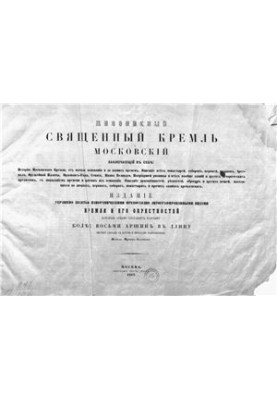The Sacred Kremlin of Moscow
 Instant download
Instant download
after payment (24/7)
 Wide range of formats
Wide range of formats
(for all gadgets)
 Full book
Full book
(including for Apple and Android)
M. : Typography C. Orlova, 1865. — 25 s. Language: Russian (old spelling). Quality: Scanned pages. The history of the Moscow Kremlin is closely connected with the history of the rise of Moscow and its struggle against the Tatar-Mongol yoke, with the history of the unification of Russian lands into a single centralized state, with the entire history of our Motherland. From here, from the Kremlin gates, the roads to all ends of the Russian land diverged. From here the Russian troops marched, and here they returned in triumphal processions after the victory. On its squares announced the decrees of the government .. In the Kremlin rushed the rebellious people, powerfully declaring their demands .. In the architectural and planning history of the Kremlin, it is possible to outline clearly defined periods due to the economic and socio-political development of the state. The first period is chronologically determined by XII - the beginning of XIV in . when the architectural appearance of the Kremlin was formed by wood-land fortifications and wooden structures of residential, public and economic buildings From this time the monuments were not preserved .. The second period takes time between the XIV in. and the third quarter of the XV in . when white-stone fortifications, temples and even residential buildings are built, the territory of the Kremlin expands significantly From these buildings, several fragments remain, giving the opportunity to present to some extent the artistic ideal of the society of that time. The third period covers the last quarter of the XV in . , 16th and 17th c. At this time, works of art were created that still constitute the artistic glory of the Kremlin, determining the aesthetic value and originality of its appearance. The fourth period can be conditionally set within the boundaries from the beginning of the XVIII century. before 1917. These two centuries are characterized by the replacement of ancient structures with new, more appropriate to the requirements of their time, as well as the creation of regular planning. Large plazas appeared, Arsenal, Senate, New Palace, Armory were erected . Only the walls, towers and Cathedral Square are left.
LF/150229068/R
Data sheet
- Name of the Author
- Unknown
- Language
- Russian
- Release date
- 1865


























